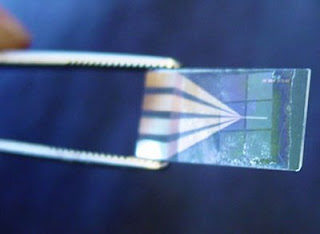MITが密かにウイルスベースのバッテリーを開発

popular Mechanics:Beyond Nano Breakthrough, MIT Team Quietly Builds Virus-Based Batteries
驚くべき進歩が,車から軍用に至る,電気電源の世界で実現しそうだ.
MITの研究者たちは,世界で最初のバッテリーを作成した.
ナノサイズのウイルスをつかったものだ.
CAMBRIDGE, Mass. — In a surprise development that could have implications for powering electronics, cars and even the military, researchers at MIT have created the world's first batteries constructed at the nano scale by microscopic viruses.
今月初めにNational Academy of Sciencesで発表された論文は,かなりの物議を醸し出した.
同チームはバッテリーの成分の3つのうち2つ-陽極と電解液を作成する事に成功した,という内容だ.
しかし今週水曜午後,プロジェクトリーダーのAngela Belcherは発表したものによると,
同チームは数年前に陽極を作成することに成功しており,複数のプロトタイプがあることのとだ.
A much-buzzed-about paper published in the Proceedings of the National Academy of Sciences earlier this month details the team's success in creating two of the three parts of a working battery—the positively charged anode and the electrolyte. But team leader Angela Belcher told PM Wednesday that the team has been seriously working on cathode technology for the past year, creating several complete prototypes.
「まだ発表はできないが,現在論文を作成し,提出しているところだ.」
と言うBelcherは2004年にMacArthur genius grantを,2006年にBreakthrough Award from PMを受賞している.
「陰極の成分は少し難しいが,いくつかの候補がある.既に稼働するバッテリーも作った」
"We haven't published those yet, actually. We're just getting ready to write them up and send them off," says Belcher, who won a MacArthur genius grant for her work in 2004 and a Breakthrough Award from PM in 2006. "The cathode material has been a little more difficult, but we have several different candidates, and we have made full, working batteries."
物理的に要素を用意する代わりに,研究者たちはウイルスにその要素(酸化コバルトなど)を植え付けた.
それによって自立的に電極が構成が出来,
人間の細胞より小さい電極を構成するためのシートの17000分の1の薄さに出来た.
Instead of physically arranging the component parts, researchers genetically engineer viruses to attract individual molecules of materials they're interested in, like cobalt oxide, from a solution, autonomously forming wires 17,000 times thinner than a sheet of paper that pack themselves together to form electrodes smaller than a human cell.
「一度ウイルスでエンジニアリングえば,要素の正しい組み合わせを解決する事が出来る」とBelcherは言う.
"Once you do the genetic engineering with the viruses themselves, you pour in the solution and they grow the right combination of these materials on them," Belcher says.
同チームは3つの構造に取り組んでいる.
フィルム構造ー人間の細胞くらい小さく,
透明なフィルムで,カードから体内に入る医療機器に至までに使えるもの.
メッシュ構造ー数十億のナノ単位の要素がつながっているもので,ノートPCや車に使えるもの.
繊維構造ー蜘蛛の糸を紡いだようなもので,織物にでき,軍用に着れるバッテリーとして使える.
「我々はまだ繊維構造からはほど遠い.一つの構造に絞って開発するが,挑戦すべきは繊維構造だ」
The team is working on three main architectures: Filmlike structures—as small as a human cell—could form a clear film to power lab-on-a-chip applications to laminate into smart cards, or even to interface with implanted medical devices. Meshlike architectures—billions of tiny nano-components all interfaced together—might one day replace conventional batteries in larger applications such as laptops and cars. And fiberlike configurations—spun from liquid crystal like a spider's silk—might one day be woven into textiles, providing a wearable power source for the military. "We definitely don't have full batteries on those [fiber architectures]. We've only worked on single electrodes so far, but the idea is to try to make these fiber batteries that could be integrated into textiles and woven into lots of different shapes," Belcher says.
同チームが使うM13ウイルスは,人工で生成できず,バクテリアによってのみ生成される.
880ナノメートル(塩の粒の500分の1の大きさ)の生物の為に,
研究者たちは分子の精度で温度,気圧に気を配り,有害物質を排出したりしている.
小さな電源要素の構造の実働が可能になった今,
この挑戦は,どう実用化するかに向かっている.
The M13 viruses used by the team can't reproduce by themselves and are only capable of infecting bacteria. At just 880 nanometers long—500 times smaller than a grain of salt—the bugs allow researchers to work at room temperatures and pressures with molecular precision, using and wasting fewer hazardous materials in the process. Now that they've demonstrated the construction of such tiny electronic components is possible, the challenge facing researchers is how to make them practical.
「今取り組んでいるのは,特定のデバイスに適応することではなく,
生物学の使ってより良い性質の成分を使い,陽極と陰極の質を向上させる事だ.」とBelcherは言う.
「まだ車を動かす事は出来ないが,改良の余地はある.
しかし,今はまだ最高の物を作る事を考えている.
もし良い物ができたら,どうやって拡張して行くかを考えなければいけない」
"What we're working on is not thinking about a particular device application, but trying to improve the quality of the anode and cathode materials—using biology just to make a higher quality material for energy density," Belcher says. "We haven't ruled out cars. That's a lot of amplification. But right now the thing is trying to make the best material possible, and if we get a really great material, then we have to think about how do you scale it." — Chris Ladd
Comments